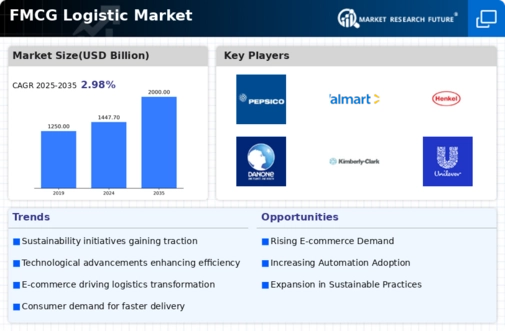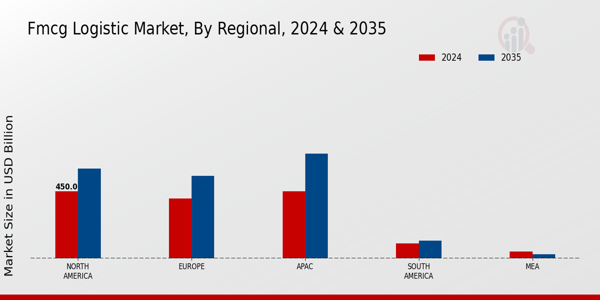E-commerce Growth
The rapid expansion of e-commerce is a primary driver of the Global FMCG Logistic Market Industry. As consumers increasingly prefer online shopping, logistics providers are adapting to meet the demand for faster and more efficient delivery services. In 2024, the market is projected to reach 1447.7 USD Billion, with e-commerce logistics playing a crucial role in this growth. Companies are investing in advanced technologies such as automated warehouses and last-mile delivery solutions to enhance operational efficiency. This shift not only improves customer satisfaction but also positions logistics firms to capitalize on the growing trend of online grocery shopping, which is expected to continue its upward trajectory.
Global Trade Dynamics
The evolving landscape of global trade is significantly influencing the Global FMCG Logistic Market Industry. Trade agreements and tariffs impact the flow of goods across borders, necessitating adaptive logistics strategies. As countries engage in trade negotiations, logistics providers must navigate complex regulatory environments to ensure compliance and efficiency. For instance, changes in tariffs can lead to shifts in sourcing strategies, prompting companies to reevaluate their supply chains. This dynamic environment presents both challenges and opportunities for logistics firms, as they seek to optimize operations in response to global trade fluctuations, thereby positioning themselves for sustained growth.
Consumer Behavior Shifts
Changing consumer preferences are a vital driver of the Global FMCG Logistic Market Industry. As consumers increasingly prioritize convenience and speed, logistics providers must adapt their services to meet these evolving demands. The rise of on-demand delivery services and subscription models reflects this shift, prompting companies to enhance their logistics capabilities. In response, many firms are investing in technology and infrastructure to ensure timely deliveries and improve customer experiences. This trend is likely to continue, with the market projected to grow at a CAGR of 2.98% from 2025 to 2035, indicating a sustained focus on meeting consumer expectations.
Market Growth Projections
The Global FMCG Logistic Market Industry is poised for substantial growth, with projections indicating a market size of 1447.7 USD Billion in 2024 and an anticipated increase to 2000 USD Billion by 2035. This growth trajectory suggests a compound annual growth rate (CAGR) of 2.98% from 2025 to 2035. Such projections underscore the increasing demand for efficient logistics solutions as the global economy expands. Factors contributing to this growth include the rise of e-commerce, technological advancements, and changing consumer behaviors. As logistics providers adapt to these trends, the industry is likely to witness significant transformations in operational strategies and service offerings.
Sustainability Initiatives
Sustainability is emerging as a critical driver within the Global FMCG Logistic Market Industry. Companies are increasingly prioritizing eco-friendly practices to meet consumer demand for sustainable products and operations. This shift includes optimizing transportation routes to reduce carbon emissions and investing in electric vehicles for delivery. Furthermore, the implementation of sustainable packaging solutions is gaining traction, as firms seek to minimize their environmental footprint. As consumers become more environmentally conscious, logistics providers that adopt sustainable practices may gain a competitive edge, potentially influencing market dynamics and contributing to the overall growth of the industry.
Technological Advancements
Technological innovations are reshaping the Global FMCG Logistic Market Industry, driving efficiency and reducing costs. The adoption of technologies such as artificial intelligence, blockchain, and the Internet of Things is becoming increasingly prevalent. These technologies facilitate real-time tracking, inventory management, and predictive analytics, which enhance supply chain visibility. For instance, AI-driven demand forecasting allows companies to optimize inventory levels, thereby minimizing waste and improving service levels. As the market evolves, these advancements are likely to contribute to a projected growth to 2000 USD Billion by 2035, indicating a robust trajectory for logistics providers who embrace these innovations.
























Leave a Comment